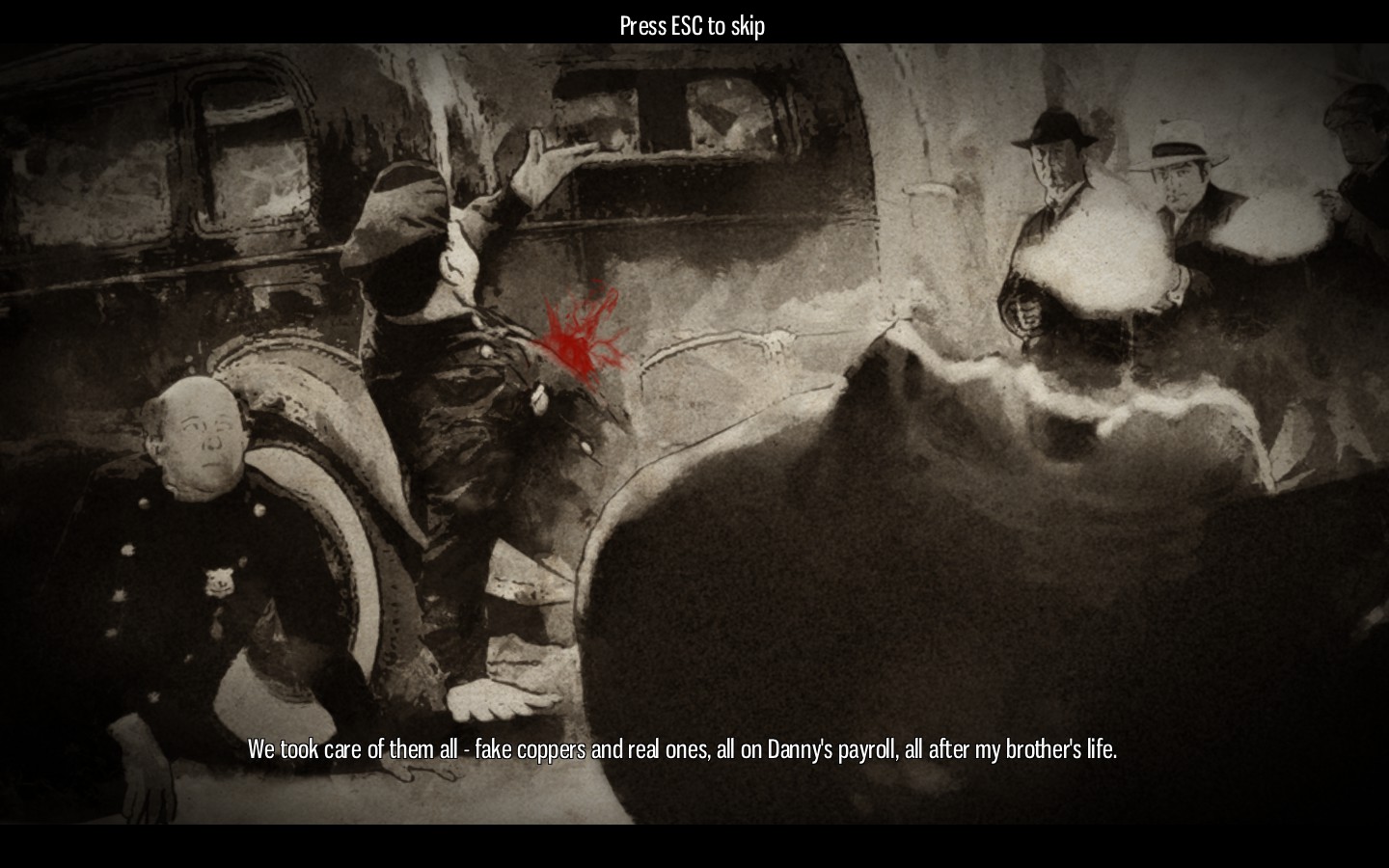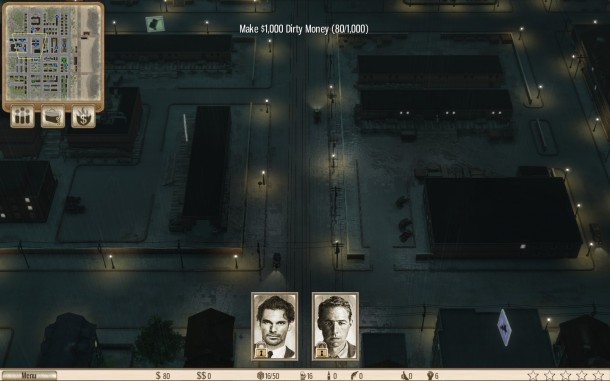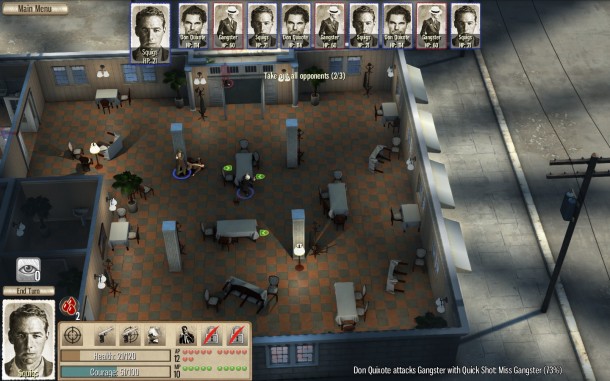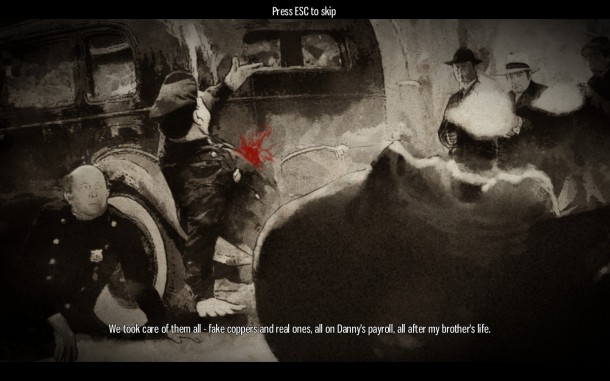What Omerta: City of Gangsters is and what Omerta: City of Gangsters wants to be are two very different things. What it wants to be is a seamless blend of Tropico-style simulation games and XCOM strategy, but what it really is reflects a disjointed mashing of the two.
The primary component of Omerta is the simulation side of things. Taking on the role of the re-nameable, but inexplicably pre-christened by the story Boss D’Angelo, you progress through missions in various sections of an Atlantic City under the choke of the Prohibition, renting establishments and setting up a multitude of legal and illegal businesses to earn money with which to complete mostly straightforward objectives.
The secondary component is the action, in which you and your hired goons — many of whom bear sublte (and not so subtle) resemblances to real Mafioso and/or Italian figures — engage in turn based strategy, utilizing strategic cover with the goal of wiping out all targets on the map before being returned to your burgeoning criminal empire.
Both aspects, viewed separately, are more than competent.
While most of the missions can be handled in a reasonable amount of time, the lack of issues usually faced in more robust simulations make it incredibly easy to bank enough money to blast through almost everything with little-to-no issue.
Where in games like SimCity or Tropico you’re faced with ever present issues like an overgrowing population, overflowing traffic, and the need for specific resources, Omerta does away with all of that. Resources are boiled down to “Dirty Money” and “Clean Money” – both of which can often be exchanged for one another at minimal loss or extravagant gain.
During the earlier missions, the quick tutorial presents you with the basic story; since the Prohibition is in full effect, you can make your money from illegal booze. The tutorial shows you how to set up a brewery and speakeasy in order to create beer and sell it for dirty money. Once past these tutorial missions you quickly realize that, generally, you never have to learn to do anything else.
While there are a few other establishments that produce goods, there are only three in the entire game: beer, liquor, and firearms. All three can be produced with minimal investment right from the start of every mission. They also stockpile so quickly that you’ll be forced to sell them constantly, either by simply selling them into the void or by completing “Jobs.”
The function of jobs is spelled out almost immediately. You can buy stockpile goods for cheap, or you can sell bulk quantities of your products for cash. You will sell a lot of stuff through jobs, and in turn you will bank a substantial amount of money – enough to break the difficulty of almost every single mission. Aside from the buying and selling of your goods, you can also do some light loansharking, buy additional storage on the cheap, go on rescue missions to bust out imprisoned members of your gang, or bribe cops to lower your “Heat.”
In the simulation side of Omerta, heat is your only real adversary.
Every illegal action you do will cause it, and once it reaches five stars an investigation will begin. After that, if enough time passes without ending the investigation, you lose. However, these can be dealt with in a number of ways: you can end it immediately if you have any deputies in your pocket, use another criminal enterprise as a scapegoat, bribe the investigators, or engage in an action sequence to destroy evidence. While the friendly deputy and scapegoat options are dependent on the state of the map, you can always bribe the investigators. Provided you can afford it, that is. Of course, destroying evidence is always an option, which makes heat a non-issue.
The lack of any real obstacles and a simplified set of variables turn the simulation side of the game into a delivery mechanism for the action. The action sequences, likewise, serve to drive the story, though they are slightly more complicated. Most action sequences allow you to bring a full crew into battle. That is, four combatants and an additional goon assigned to a support role.
The support role is described at the beginning of the encounter and can range from getting enemies drunk to lower their effectiveness to automatically attacking enemies at random from the shadows. There are a few other effects, and they’re allsurprisingly useful at times. The support structure is a genuinely interesting addition to the modern strategy formula.
The actual action aspect is, however, slightly less robust than Omerta’s contemporaries. Each character, armed with either one of four ranged weapons or one of three melee weapons has a number of both “Movement Points” and “Action Points.” Utilizing walls, vehicles, doors, and a number of other types of cover each character can use one of three weapon-specific abilities or other character-specific tactics to take out enemies.
While these action sequences may have various objectives within, each can be won by simply killing everyone else. For example, when engaging in a bank heist the objective is normally to obtain the money and escape the bank, but it is often far easier to simply enter the bank, kill everyone, get the money and then proceed to kill everyone who spawns outside the bank to prevent your escape. Likewise, in a sequence that limits you to a single character and prompts you to escape, you can also win the encounter through killing.
The multiplayer, likewise, has its fair share of problems. With only two cooperative multiplayer missions and two competitive missions, the novelty quickly wears thin. This is compounded by the fact that communication, once in a session, is impossible. For anyone looking to set up the best team with the best weapons, multiplayer quickly becomes a slough.
On their own, the two sides of the game are fine. They’re not spectacular, but likewise they aren’t unbeatable or otherwise broken in any way. They do exactly what they need to do in order to present an entirely playable experience.
The story, on the other hand, is surprisingly engaging. What begins as a search for the American Dream quickly evolves into a tale of crime, murder and family, and is punctuated with motion comic-like cutscenes filled with impressive artwork. The plot is so enthralling that despite the campaign taking a respectable fifteen hours to complete, time seems to fly past. Each completed mission means a little more story and one step closer to a satisfying end.
Omerta: City of Gangsters is an interesting experiment. Although it doesn’t specifically fail at anything it sets out to accomplish, the simulation and action sections of the game become rote; things to be dealt with in order to get a bit more of the exceptional story.
This review is based on a copy of the game provided by the publisher.





No Comments